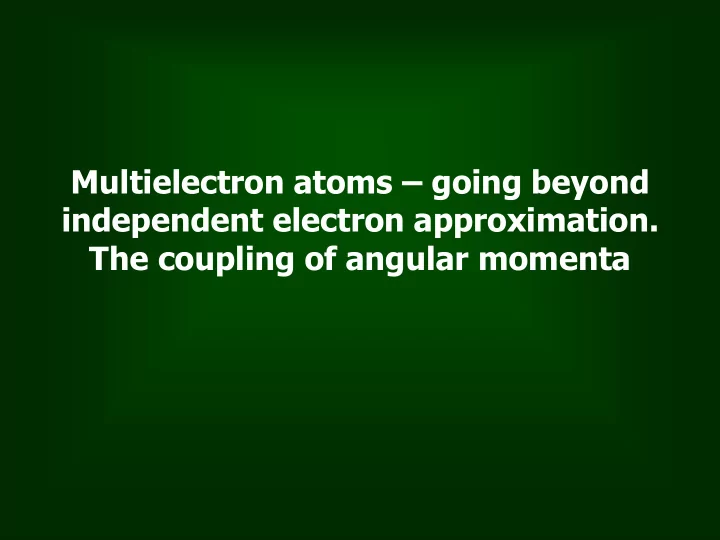

Multielectron atoms – going beyond independent electron approximation. The coupling of angular momenta
• Independent electron approximation – IEA • To each electron we may assign a quantum state, defined by a set of quantum numbers (n, l, m l , m s ) • The atom is characterized by a well defined electron configuration • A configuration is defined by the number of electrons on each orbital (characterized by n and l) Ex: Phosphorus 1s 2 2s 2 2p 6 3s 2 3p 3 .
• The best IEA method is the Hartree-Fock method • It takes into account the Pauli exclusion principle • The totally antisymmetric wavefunctions are expressed by the Slater-determinants
• The Hartree-Fock method finds the best wavefunctions and energies within the IEA • This is not exact because of the nonspherical components of the electron-electron interactions • Part of these interactions are related to the coupling of angular momenta – Electrostatic interactions – Spin-orbit interactions • We assume in the following calculation, that the electrostatic interactions are larger than the spin-orbit ones (Russel-Saunders coupling, valid for small Z atoms)
• These operators and H commute, so they have a common set of eigenfunctions • These eigenfunctions should obey the eigenequations • The Slater-determinants do not obey always these requirements
• The Slater-determinants are eigenfunctions of the one- electron angular momentum operators • We want to construct wavefunctions from the Slater- determinants, which are eigenfunctions for the whole electron system. • We make a transformation from the one-electron angular momenta representation to the total angular momentum representation • This procedure is the coupling of angular momenta
• System with 2 electrons • At this moment we neglect the spin • The relationship between the one-electron (l 1 ,m 1 ,l 2 ,m 2 ) and the total angualar momentum (l 1 ,l 2 ,L,M) representation may be written
• Taking into account the spins
Electrostatic corrections to the Hartree-Fock method • Orbit-orbit and spin-spin interactions • Russel-Saunders coupling • We neglect the spin-orbit interactions • Perturbational method • The unperturbed wavefunctions are eigenfunctions of • The first-order perturbational correction may be written
• The vector may be expressed as a linear combination of Slater determinants • Example for the dependence of the energy on the spin coupling – the helium atom • Triplet case – S=1, orthohelium
• The sum reduces to one term -> one Slater-determinant • Separating the spatial and the spin part of the wavefunction
• The Slater-determinants
• Singlet case – S=0, parahelium
• The Slater-determinants
• The spatial wavefunction
• More general – Hund’s rule for the spin: For a given electron configuration, the term with maximum multiplicity (2S+1) has the lowest energy. • Hund’s rule for the angular momentum For a given multiplicity, the term with the largest value of L has the lowest energy.
Recommend
More recommend